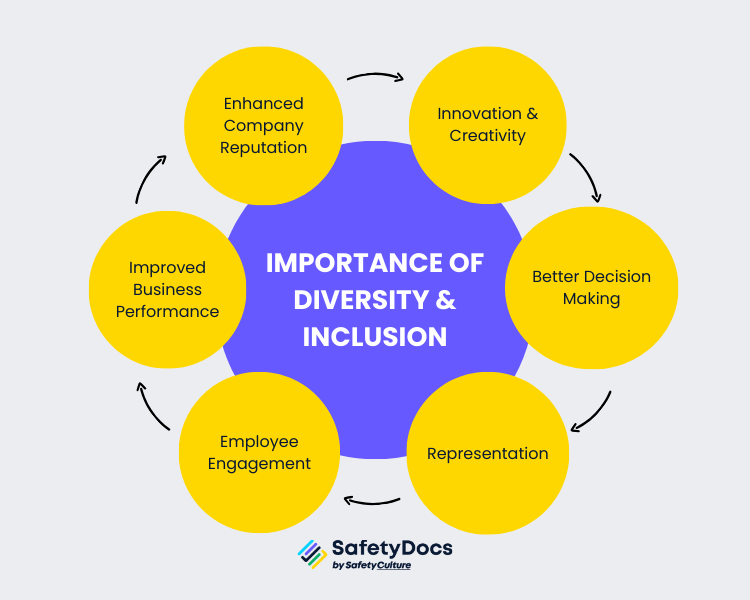Diversity and Inclusion are interconnected concepts crucial in the workplace and other social environments. According to the Australian Bureau of Statistics, in 2021, 27.6% of the population were born overseas, and 46% had at least one parent who was born overseas. This diversity brings a wealth of ideas, perspectives, and experiences that can give businesses a competitive edge. However, it's not just about having a diverse workforce; creating an inclusive environment is equally crucial.
What is Diversity and Inclusion
Diversity and Inclusion, often abbreviated as D&I, are fundamental concepts that play a crucial role in fostering positive and dynamic environments, especially within the workplace. Let's break down these terms to understand their significance:
- Diversity encompasses abundant human qualities and attributes within a group, organisation, or community. It is a testament to the richness and variety among individuals, fostering inclusivity, creativity, and growth. It goes beyond the visible differences such as race, gender, age, and ethnicity. It encompasses various backgrounds, experiences, perspectives, and abilities. People bring unique qualities and characteristics in a diverse setting, contributing to a rich tapestry of ideas, talents, and viewpoints.
- On the other hand, inclusion is about creating an environment where these diverse individuals feel valued, respected, and equally treated. It ensures that everyone has equitable access to opportunities and resources to make meaningful contributions to the organisation's success.

Importance of Diversity & Inclusion
Diversity and inclusion are no longer simply buzzwords; today, they're integral to business success. They are vital for several reasons, particularly in a professional setting. Here are a few key points:
1. Innovation and Creativity
When individuals from diverse backgrounds come together, their unique perspectives and experiences stimulate creativity and innovation. This can lead to fresh ideas, problem-solving approaches, and a competitive business advantage. Companies with above-average diversity scores drive 45% of average revenue from innovation, while those with below-average diversity scores drive only 26%
2. Better Decision Making
Diverse teams are more likely to examine facts thoroughly and less likely to engage in groupthink. Individuals with distinct backgrounds and viewpoints bring different insights, leading to more well-rounded decisions.
3. Representation
Inclusive organisations ensure that all voices are heard and valued, not just the majority. This can lead to policies and products that are more representative and fair. It also creates a sense of belonging and fosters a positive work culture.
4. Employee Engagement
Employees are more likely to feel engaged and committed to their organisation if they feel included and valued for their unique contributions.
5. Improved Business Performance
Studies have demonstrated a positive correlation between workforce diversity and financial performance. Research reveals that companies with a higher level of gender diversity are 21% more likely to achieve above-average profitability, while ethnically diverse companies have a 33% higher likelihood of attaining the same.
6. Enhanced Company Reputation
Organisations appeal to a broader customer base and are more likely to attract top talent with a reputation for embracing diversity and inclusion. This can lead to increased customer loyalty and a more competitive workforce.

Challenges of Creating Diverse & Inclusive Environments
Despite the benefits, many organisations need help creating diverse and inclusive environments. Some common obstacles include:
Resistance to Change
People naturally resist change, especially when it threatens their status quo. Introducing diversity and inclusion initiatives may cause discomfort or fear among some organisation members. Fears such as losing opportunities or facing backlash can hinder progress.
Unconscious Bias
Even with the best intentions, people often harbour unconscious biases that can affect their behaviour and decisions. These biases can hinder efforts to create a genuinely inclusive environment.
Tokenism
There's a risk that diversity and inclusion efforts can devolve into tokenism, where individuals are included to meet quotas or appear diverse rather than to foster genuine inclusion. When this happens, the actual benefits of diversity and inclusion may still need to be realised.
Lack of Understanding
Only some understand the importance of diversity and inclusion or know how to promote it effectively. For example, some may believe that being "colourblind" or ignoring diversity issues is the best approach. In contrast, in reality, this can be damaging.
Communication Barriers
Language and cultural differences can lead to communication difficulties, misunderstandings, and conflicts in diverse environments. An individual's background and experiences can also affect how they interpret messages or behave in certain situations.
Retention Challenges
Even if an organisation successfully recruits a diverse workforce, it may need help to retain these employees if they feel genuinely included and valued. The turnover rate for various employees may be higher if they face discrimination or feel isolated.
Inadequate Leadership Commitment
For workplace diversity and inclusion efforts to succeed, they need strong support from inclusive leadership. When leaders aren't fully committed, initiatives may be seen as just a "tick-box" exercise rather than creating real change. Without commitment, initiatives may lack the necessary resources or fail to gain traction.
Australian Laws and Regulations Related to Diversity and Inclusion
Racial Discrimination Act of 1975 (RCA)
This Act ensures that everyone is treated equally under the law, irrespective of their race, colour, or national or ethnic origin. It is illegal to engage in discriminatory practices based on race, colour, lineage, or national or ethnic origin.
Age Discrimination Act 2004
The Age Discrimination Act 2004 prohibits discrimination on the grounds of age in various areas of public life, including employment, education, access to premises, provision of goods, services, facilities and accommodation, among others. It seeks to eliminate age-based prejudice, ensuring everyone has the same rights and opportunities regardless of age. The Act also includes provisions for positive discrimination, which allows for measures that help reduce disadvantage experienced by specific age groups.
Disability Discrimination Act 1992
The Disability Discrimination Act 1992 makes it unlawful to discriminate against someone due to their disability in various settings, including education, employment, and access to public spaces and services. The legislation covers a wide range of disabilities, including physical, intellectual, psychiatric, sensory, neurological, and learning disabilities, as well as diseases that result in disability. It advocates for equal rights, opportunities, and access for people with disabilities and encourages change in societal attitudes towards disability.
Sex Discrimination Act 1984
The Sex Discrimination Act 1984 aims to prevent discrimination based on sex, gender identity, intersex status, sexual orientation, marital or relationship status, family responsibilities, pregnancy or potential pregnancy, and breastfeeding. This applies in various areas of public life, such as employment, education, provision of goods and services, accommodation, and more. It's designed to promote equality between men and women and to allow people to participate fully in society without being limited by prejudice and stereotype assumptions.
Australian Human Rights Commission Act 1986
The Australian Human Rights Commission Act 1986 outlines the functions and powers of the Commission, which include investigating and resolving complaints of discrimination and human rights breaches, promoting understanding and public awareness of human rights, conducting research to inform policy and legislative developments, and advising the government on human rights issues. The Act covers various grounds of discrimination, including race, colour, sex, disability, and age.
Compliance
While no laws mandating that employers must undertake diversity and inclusion initiatives, it is unlawful to discriminate against a person or group based on protected attributes, including gender, race, sex, sexual orientation, age, and disability. Employers are encouraged to ensure their diversity and inclusion initiatives and policies are legally and reasonably sound. They do not unintentionally and unlawfully discriminate when hiring and firing employees.

Introducing Our Diversity and Inclusion Policy
To help workplaces create a diverse and inclusive environment, we recommend implementing a Diversity and Inclusion Policy.
What are Diversity and Inclusion Policies
A diversity and inclusion policy is a written statement that outlines an organisation's commitment to creating a diverse and inclusive environment. It outlines the principles, goals, and strategies for promoting workplace diversity and inclusion throughout the organisation or workplace.
Diversity & Inclusion Policy by SafetyDocs
SafetyDocs by SafetyCulture's new policy aims to help your workplace foster a culture that embraces and celebrates diversity and inclusion. It sets out our commitment to promoting an inclusive environment where everyone feels valued, respected, and empowered. The policy's new features include:
- Details of the policy, including the purpose, scope, and definitions.
- Step-by-step guide of actionable procedures for recruitment, training and development, performance management, and more.
- Strategies for promoting diversity and inclusion in the workplace include awareness training, inclusive language guidelines, and mentorship programs.
- Information on how to report any concerns or instances of discrimination or harassment.
- Associated forms and templates to help you implement the policy effectively, such as checklists for conducting diversity training.
- A statement on the consequences of violating the policy, including disciplinary measures.
Benefits of Using a Diversity & Inclusion Policy
A template like SafetyDocs offers can be a valuable tool for organisations promoting diversity and inclusion. Some benefits include:
- It outlines clear guidelines and expectations for fostering workplace diversity and inclusion, making it easier for all members of an organisation to understand their role in creating an inclusive environment.
- It helps standardise procedures across the organisation, ensuring that diversity strategy and inclusion framework are consistent and effective.
- It establishes accountability by outlining consequences for violating the policy, ensuring that diversity and inclusion are taken seriously in the organisation.
- It provides a framework for continuous improvement and adaptation to changing circumstances or challenges. As diversity and inclusion issues evolve, the policy can be updated accordingly.
Who Needs a Diversity and Inclusion Policy?
All organisations, regardless of size or industry, can benefit from having a diversity and inclusion policy. Here's why:
- Small Businesses: Creating an inclusive culture is crucial even with a small team. This will set the tone for future growth and help attract diverse talent.
- Mid-Sized Companies: As your company grows, so does the need for formal policies around diversity and inclusion. These policies can help prevent discrimination and ensure that everyone feels valued and respected.
- Large Corporations: A diversity and inclusion policy is critical for large organisations. It can help manage a diverse workforce, improve decision-making, and enhance the company's reputation.
- Non-Profit Organisations: Non-profits often work with diverse communities and must reflect the people they serve.
- Educational Institutions: Schools and universities should foster an environment where all students and staff feel included and represented.
- Government Agencies: As public entities, government agencies are responsible for reflecting the diversity of the citizens they serve.
Why Choose SafetyDocs
SafetyDocs understands the importance of creating a diverse and inclusive workplace. Opting for SafetyDocs reflects your commitment to a company deeply invested in the safety of its customers.
Our experts are dedicated to delivering compliant WHS (Work Health and Safety) documentation that prioritises ease of use and understanding. Benefit from the following when you utilise our diversity and inclusion policy template:
- Comprehensive Product Range: We have extensive safety documentation tailored to diverse needs.
- Affordable: We believe in making safety accessible to all. Our documents are reasonably priced without compromising on quality.
- Compliance: Stay assured with documentation that meets compliance standards and is consistently updated to align with the latest regulations.
- User-Friendly Interface: Navigating safety documentation should be seamless. Our materials are designed to be user-friendly, ensuring accessibility for everyone.
- Instant Download Gratification: Enjoy the convenience of instant downloads, getting you quickly on the path to enhanced safety measures.
Additional Resources:
Start Your Journey Today!
Embrace a culture of diversity and inclusivity in your organisation with SafetyDocs. Download our Diversity and Inclusion Policy now and take the first step towards a more inclusive workplace.
Our team of experts is dedicated to providing accurate and informative content. Craig Cruickshank, our senior HSEQ advisor at SafetyDocs by SafetyCulture has reviewed this blog post to ensure the highest level of quality.
Learn more about Craig's work on LinkedIn for more industry insights.
Available for instant download and supplied in fully editable MS Word format for use in your business.
Please note that the above information is provided as a comment only and should not be relied on as professional, legal or financial advice.
Share This Article
